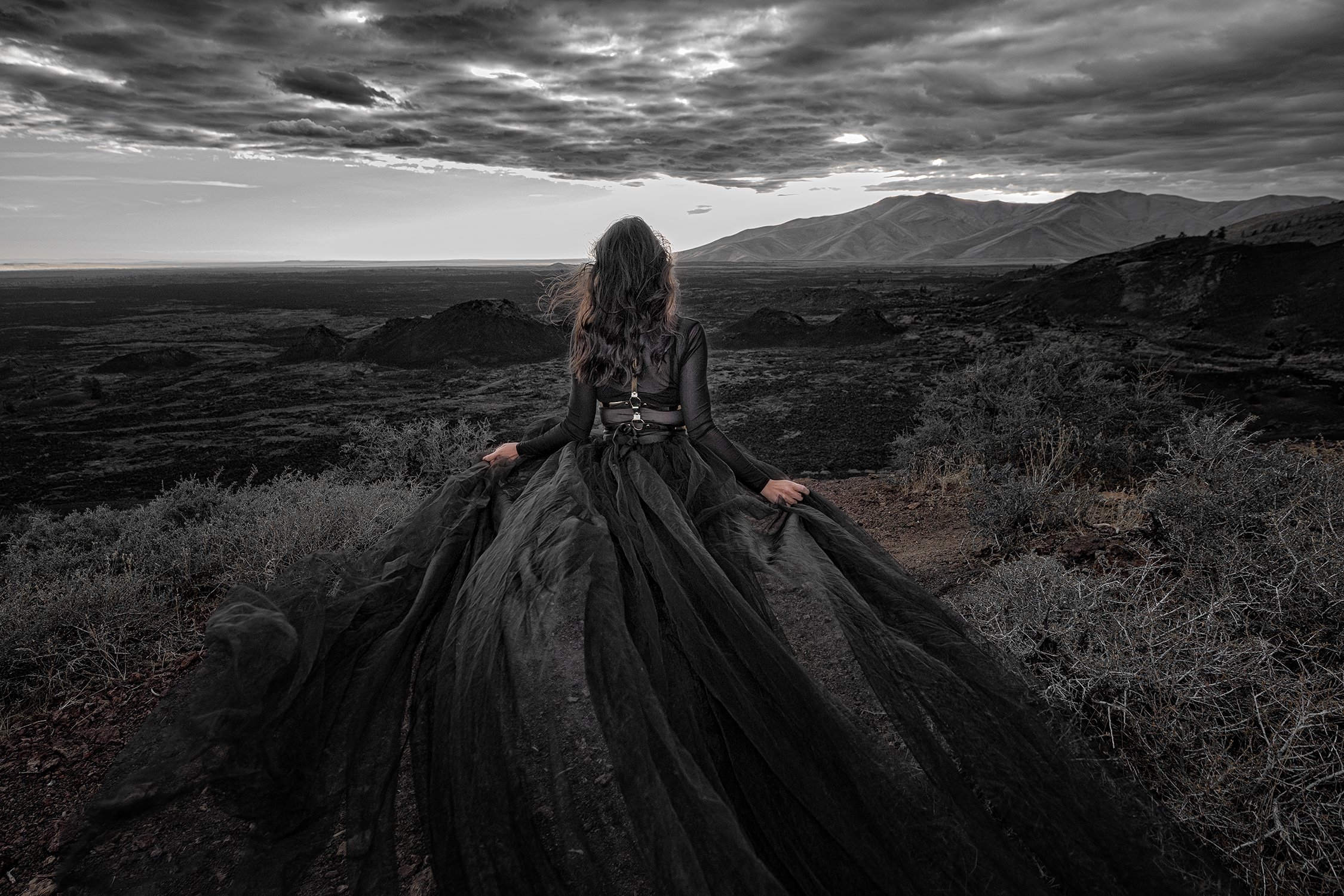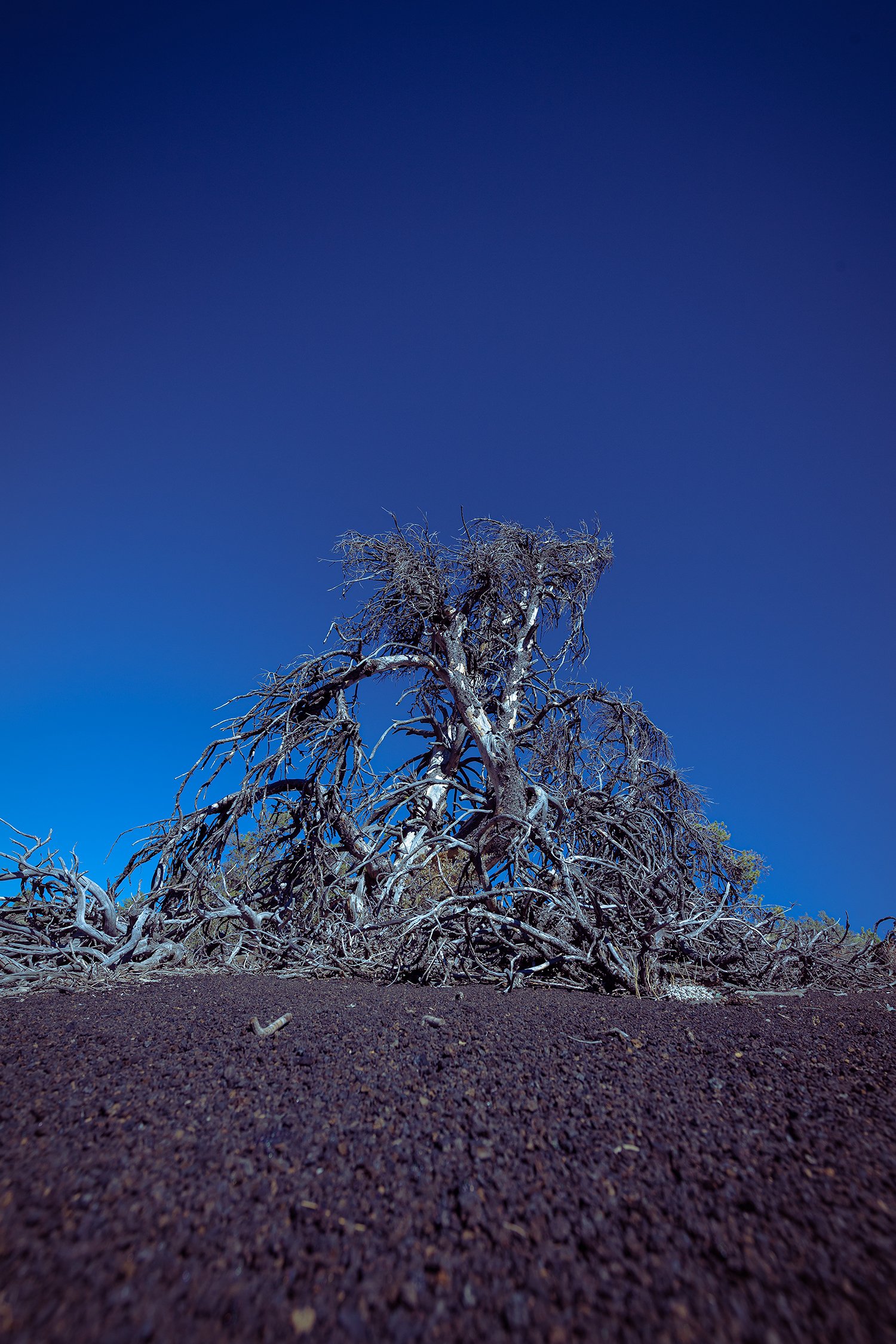The Craters of the Moon. Is a Goth Dream.
I didn’t expect THAT at all. When I google this place I thought to myself: oh, very cool place to visit. But I didn’t expect to be totally blown away. My inner goth was excited to behold with my own eyes all-black otherworldly landscape with very little and weird life on it.
My three kids were excited too, but for a different reasons. The Craters of the Moon (National Monument and Preserve) is a mysterious place with black moon-like surface of ancient lava. It will take you through the surreal environment, and so eerily beautiful! Pretty barren landscape, with lots of twisted trees dispersed throughout, that look like they’re out of a scary movie. Should I even mention the bat caves? I think I should because you will need to get a trip permit, which are free and can be obtained at the Visitor Center. And another useful preparations that I will drop later.
The Craters of the Moon is often overlooked by road trippers because it’s in the middle of nowhere and technically not a “national park”, but it’s so worth of visiting. Believe it or not, the same volcanic hot spot that is active in Yellowstone today once formed the Craters landscape. There’s actually a lot of life in the park, with over 400 square miles of thriving sagebrush grassland, and it also has some of the world’s best examples of lava tubes, tree molds, and even the world’s deepest rift crack, at 800 feet deep.
The most accessible way to explore the park is by driving the paved 7 mile loop road. Prepare to do a lot of stopping for sight-seeing or even hiking.
But before getting to the one-way portion of the Loop Road, a short half mile walk through Devil’s Orchard is a must. Also it is the only handicap and stroller friendly hike in the park. It has lava fragments as well as some older, very uniquely shaped trees. Also, along this trail you will learn about the human impact on the park and safeguards for protecting the park today. It is a great trail if you want to learn more about the Craters of the Moon National Monument.
Useful tips:
Always have a full tank of gas. There are a long stretch of nothing but desert and black rock. On the way to and back from the National Monument.
Water. Is just accentual in any outside activity.
Think layers. It is either always cold, or very hot. Windy as well.
Wear sturdy shoes, no sandals!
Bring sunscreen, sunglasses, and a hat because this place has zero shade.
Avoid hiking in high noon. Plan this time to explore the caves.
The first hike we took was Broken Top Loop Trail. This 1.8 mile-long trail will give you views to just about every unique volcanic feature in the park. It’s a little steep getting up near the top and the loose ground makes for slightly difficult footing, but nothing overly challenging.
I’d recommend going the opposite direction around the loop rather than following the number markers, because that way the uphill is way shorter. Steeper, but only lasts a little bit. If you follow the number markers, it’ll be uphill for way more of the hike.
There is a brief period on the end of the loop (if you go opposite direction), where you have to walk over the lava tubes to make it back to the gravel path. This section is cool to walk on, well marked and would be considered easy to the average hiker.
This trail also provides access to the Wilderness Trail. Like its name suggests, you will be immersed in wilderness and solitude once going on this 8 mile-long hike in the backcountry. The trail itself is not that difficult but not specifically dynamic or interesting. We did not completed the whole trail, but just walked half way to the Lava Trees area. Skip the Tree Molds trail (same parking lot) if you are planing to go on the Wilderness Trail. The Lava Trees are much more unique than two unnoticeable tree molds at the end of the 2-mile trail.
Lava tree molds are cavities or holes in the ground that mark where forests once stood in the path of an approaching lava flow.
When lava flows through a forest, it swirls around tree trunks and quickly solidifies. Moisture in the wood and gas bubbles in the rocks form excellent insulation against instant incineration. As the level of the surrounding flows rises, the trees eventurally burn off while a thick crust forms on the surface of the lava flow. Though the trees disappear, their footprints in the lava remain.
Probably one of the coolest spots in Craters of the Moon is the 6100-foot tall Inferno Cone. Extremely worth it, even if you have a fear of heights. It’s a short but very steep half mile climb to the peak will give you with 360-degree views of the surrounding high plains. From the top you can see cinder cones and the Great Rift.
A big part of the Inferno Cone is the fact that the trail is 100% cinder. There is just something about hearing the crunch as you take each step on this unusual surface.
Aside from the mentioning above, It’s a great photoshoot spot, with the lush lone tree growing on the rim of the cone.
Unfortunately, we were not able to explore caves due to the personal health, but I hope we’ll be more lucky the next time.
But there are some useful tips:
Make sure to obtain a permit at the Visitors Center before entering any of the caves.
IMPORTANT! Do not wear any clothing that you have ever worn in other caves. This is probably the most important thing that they will ask about before issuing you a cave permit. The purpose of the pass is to go over protection for the local bat population against White Nose Syndrome. White-Nose Syndrome is a deadly bat fungus that can be easily transported on soft or porous items such as shoes, clothes, and bags. If you have been in any caves outside of the national preserve then you need to ensure these items do not enter the cave with you.
Flashlights. Duh, the caves are dark. Some are extremely dark. Bring a light source with you. Headlamps would be handy but small flashlights would work as well.
Consider what you may need to protect yourself from injuries. Depending on which caves you are exploring, you may want a helmet, knee pads, and gloves.
Closed Toe Shoes are required in the caves.
Food is not permitted inside any of the caves.
So, why this name: the Craters of the Moon? First of all, because it looks like you are actually looking at the surface of the moon while looking through a telescope. Secondly, in 1969, Apollo Astronauts Alan Shepard, Eugene Cernan, Joe Engle, and Edgar Mitchel went to Craters of the Moon to learn about geology here on earth before landing on the Moon. These guys from NASA were great pilots but no geologists, and their supervisors thought, that this type of training will come handy once they land on the Moon. I’m neither of the two, so I wouldn’t know.
The best time of year to visit Craters of the Moon is in the fall because crowds thin and the weather is perfect for spending time outdoors. Wildflowers are at their peak in June. Summer gets hot, so if you’re visiting then, plan accordingly. Enjoy hiking early in the day, as there’s little shade, and plan to explore caves and lava tubes during the hottest part of the day.
The last point to remember is that there is no such thing as a sleeping volcano. Craters of the Moon is the structure left by a “Shield Volcano”. In other words, a volcano something like what is going on in the Hawaiian Islands where the lava flow to the surface and just spreads over the surface. Around 15,000 years ago, lava began flowing upward through the cracks, creating a plain of lava rock and mini volcanoes called cinder cones. The last known eruption was about 2,000 years ago, with future eruptions possible. There is also a super volcano just below the surface in another National Park a little north and east called Yellowstone National Park. So, any minute now…






















